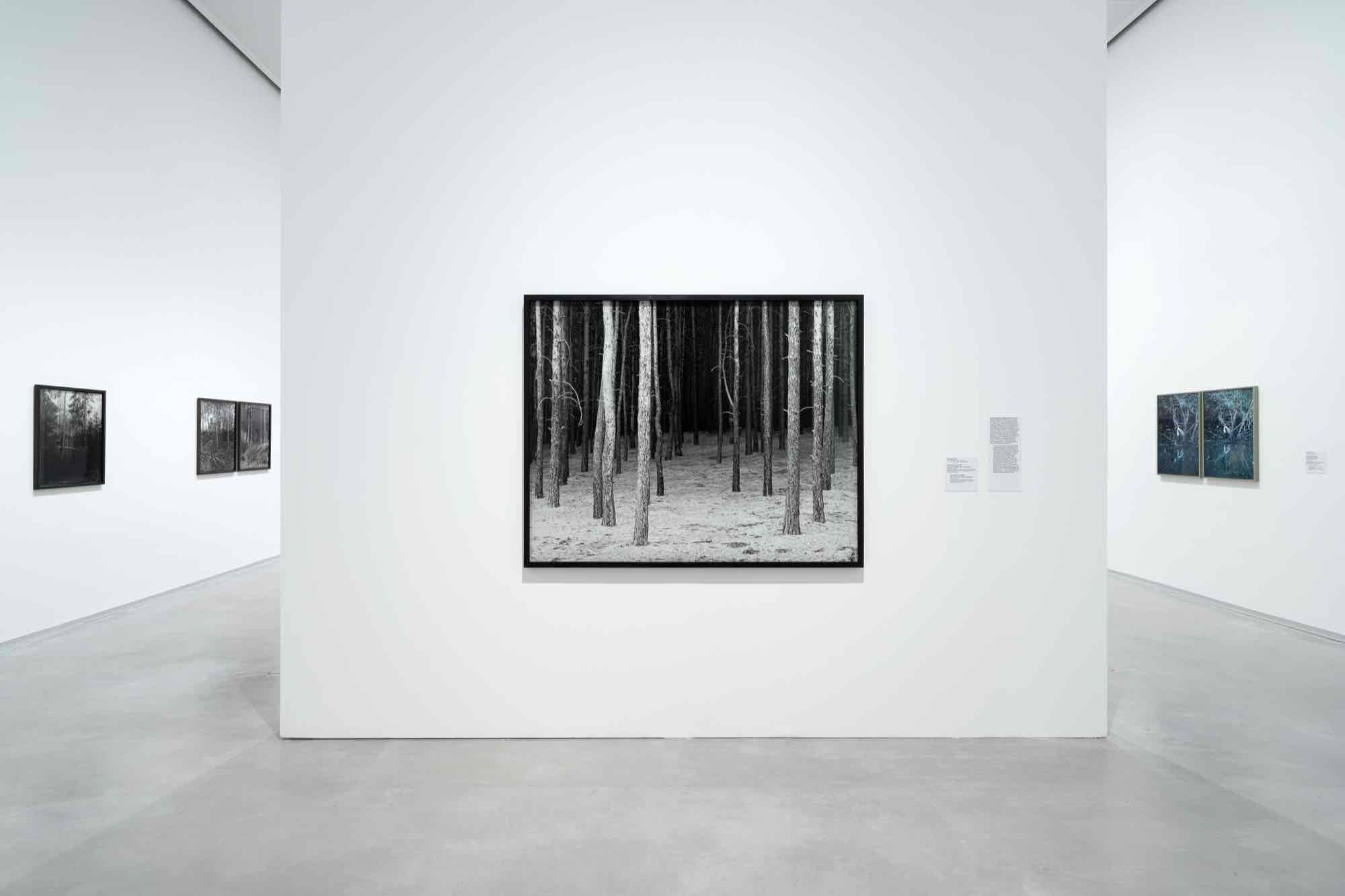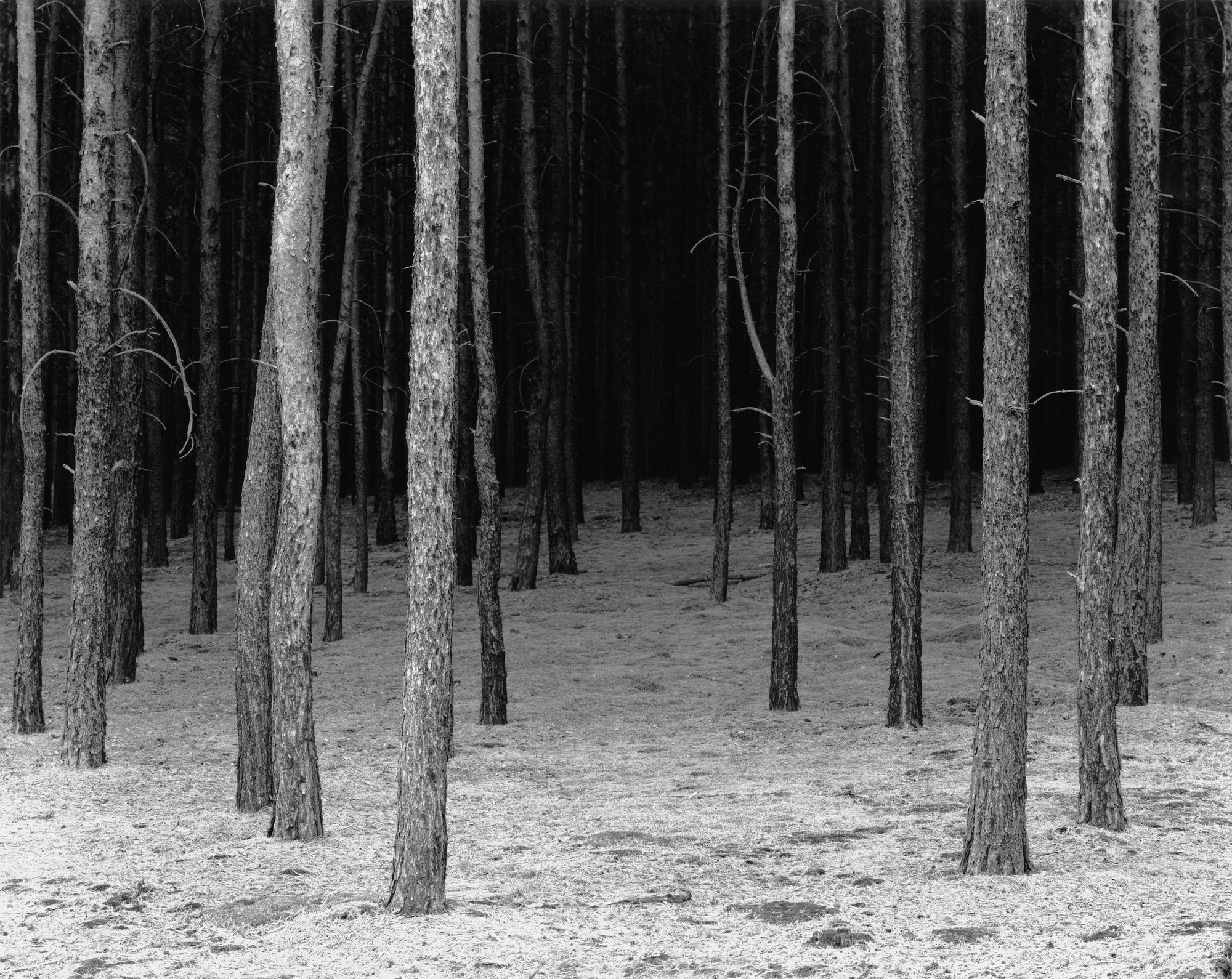Greenery
Plants in contemporary photography
12 Oct 2023 - 22 Jan 2024

Exhibition view “Greenery. Plants in contemporary photography”, (works shown: Susanne Kriemann, Mimi Cherono Ng’ok, Ingar Krauss, Folkwang-Auriga-Verlag featured by Andrzej Steinbach), photo: © dotgain.info

Exhibition view “Greenery. Plants in Contemporary Photography” (works shown: Ingar Krauss, Falk Haberkorn, Susanne Kriemann), © VG Bild-Kunst, Bonn 2023, Photo: © dotgain.info

Falk Haberkorn, Schonung #2, Aus der 4-teiligen Serie „Schonung“, 2003/04 © VG Bild-Kunst, Bonn 2023
Lofty firs, dense mangroves, bizarre pistils – the shapes created by the plant world are prodigious. Embedded within their own complex, highly sensitive ecosystems, plants intertwine with human culture in many different ways.
Contemplating them can soothe the nerves, offer food for thought and trigger powerful emotions such as fear or anxiety. Plants have found favour as material for photographic techniques and experiments since the early 19th century.
The exhibition “Greenery. Plants in contemporary photography” takes up this multifaceted theme. It features present-day works, most of them from the museum’s Photography Collection, which examine the often ambivalent relationship between humans and plants through the eye of the camera.
Six artistic perspectives
Falk Haberkorn (*1974 East Berlin) plays with the contradictions between a romantic reverence for forests and the environmental impacts and commercial interests that threaten them. The artist describes his technique as a “visual interrogation” of things purportedly plain to see”. His enigmatic work “Clearing” triggers emotions and arouses memories of fairy tales and legend in Western cultures.
Mimi Cherono Ng’ok (*1983 Nairobi, Kenya) imbues her images of plants, printed like clippings on rice paper, with personal emotions. With her strong awareness of the mutability of our surroundings she also travels to tropical climate zones. She takes photographs in the Dominican Republic, on the margins of urban settlements and in the gardens and parks of São Paolo and Nairobi.
Susanne Kriemann (*1972 Erlangen) has a keen sense of life’s fragility on our globalised planet. For her series “Mngrv polymersday” (2020) she took photographs among the Indonesian mangroves on Pulau Bintan, where ocean pollution has led to waste from human civilisation becoming entangled with the fragile ecosystem. The involuntary amalgamation of flora and synthetic junk such as fishing nets and plastic bags is depicted by this artist as a unity.
Andrzej Steinbach (*1983 Czarnkow, Poland) created his twenty-part series “Ashtray and Yoga Mat” (2023) at the invitation of the Berlinische Galerie. The artist consulted 132 historical photographs of plants, fungi and minerals in the Folkwang-Auriga Archive (1928–1932), choosing those that he found most interesting as pictures. He then matched his selection to photographs of consumer goods and everyday objects. Nature and culture are no longer antithetical but connected. He invites the viewer to consider the interplay between things made by human hand and things that grow naturally.
“Sculpture, object or living plant?” asks Stefanie Seufert (*1969 Göttingen), whittling the evergreen tree down to pure form with her photography. The conifer, captured in front gardens and parks, is the motif for her series “01-1 – 1-10” (2006–10), which pursues ambivalence and comparison. Can her series be read as reflecting documentary typologies and does a single image signify anything more than itself? Stefanie Seufert explores the properties of photography, beginning where pictures defy genre classification.
Ingar Krauss (*1965 East Berlin) takes his photographs in the Black Forest, in Brandenburg and in Norway. In his seemingly harmonious compositions he tracks down tensions between human interventions in the forest and indomitable nature. Stacked logs, branches propped against trees, scattered deadwood and heaps of twigs are the result of both profit-oriented and sustainable forestry management. These multiple human orderings characterise the woodlands of Europe.
The exhibition encourages visitors to respond to their own emotions, to sharpen their environmental awareness and to perceive the harmony between nature and culture.
Artists:
Mimi Cherono Ng‘ok (*1983 Nairobi, Kenia)
Falk Haberkorn (*1974 East-Berlin)
Ingar Krauss (*1965 East-Berlin)
Susanne Kriemann (*1972 Erlangen),
Stefanie Seufert (*1969 Göttingen)
Folkwang-Auriga-Verlag featured by Andrzej Steinbach
(*1983 Czarnkow, Polen)
Contemplating them can soothe the nerves, offer food for thought and trigger powerful emotions such as fear or anxiety. Plants have found favour as material for photographic techniques and experiments since the early 19th century.
The exhibition “Greenery. Plants in contemporary photography” takes up this multifaceted theme. It features present-day works, most of them from the museum’s Photography Collection, which examine the often ambivalent relationship between humans and plants through the eye of the camera.
Six artistic perspectives
Falk Haberkorn (*1974 East Berlin) plays with the contradictions between a romantic reverence for forests and the environmental impacts and commercial interests that threaten them. The artist describes his technique as a “visual interrogation” of things purportedly plain to see”. His enigmatic work “Clearing” triggers emotions and arouses memories of fairy tales and legend in Western cultures.
Mimi Cherono Ng’ok (*1983 Nairobi, Kenya) imbues her images of plants, printed like clippings on rice paper, with personal emotions. With her strong awareness of the mutability of our surroundings she also travels to tropical climate zones. She takes photographs in the Dominican Republic, on the margins of urban settlements and in the gardens and parks of São Paolo and Nairobi.
Susanne Kriemann (*1972 Erlangen) has a keen sense of life’s fragility on our globalised planet. For her series “Mngrv polymersday” (2020) she took photographs among the Indonesian mangroves on Pulau Bintan, where ocean pollution has led to waste from human civilisation becoming entangled with the fragile ecosystem. The involuntary amalgamation of flora and synthetic junk such as fishing nets and plastic bags is depicted by this artist as a unity.
Andrzej Steinbach (*1983 Czarnkow, Poland) created his twenty-part series “Ashtray and Yoga Mat” (2023) at the invitation of the Berlinische Galerie. The artist consulted 132 historical photographs of plants, fungi and minerals in the Folkwang-Auriga Archive (1928–1932), choosing those that he found most interesting as pictures. He then matched his selection to photographs of consumer goods and everyday objects. Nature and culture are no longer antithetical but connected. He invites the viewer to consider the interplay between things made by human hand and things that grow naturally.
“Sculpture, object or living plant?” asks Stefanie Seufert (*1969 Göttingen), whittling the evergreen tree down to pure form with her photography. The conifer, captured in front gardens and parks, is the motif for her series “01-1 – 1-10” (2006–10), which pursues ambivalence and comparison. Can her series be read as reflecting documentary typologies and does a single image signify anything more than itself? Stefanie Seufert explores the properties of photography, beginning where pictures defy genre classification.
Ingar Krauss (*1965 East Berlin) takes his photographs in the Black Forest, in Brandenburg and in Norway. In his seemingly harmonious compositions he tracks down tensions between human interventions in the forest and indomitable nature. Stacked logs, branches propped against trees, scattered deadwood and heaps of twigs are the result of both profit-oriented and sustainable forestry management. These multiple human orderings characterise the woodlands of Europe.
The exhibition encourages visitors to respond to their own emotions, to sharpen their environmental awareness and to perceive the harmony between nature and culture.
Artists:
Mimi Cherono Ng‘ok (*1983 Nairobi, Kenia)
Falk Haberkorn (*1974 East-Berlin)
Ingar Krauss (*1965 East-Berlin)
Susanne Kriemann (*1972 Erlangen),
Stefanie Seufert (*1969 Göttingen)
Folkwang-Auriga-Verlag featured by Andrzej Steinbach
(*1983 Czarnkow, Polen)
